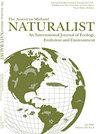The Rocky Road to Eastern Hellbender (Cryptobranchus a. alleganiensis) Recovery in Ohio: An Evaluation of Habitat in Ohio's Streams
IF 0.6
4区 环境科学与生态学
Q4 Agricultural and Biological Sciences
引用次数: 1
Abstract
Abstract. Determining habitat characteristics that influence the contemporary distribution of species is imperative for effective conservation planning. The Eastern Hellbender (Cryptobranchus a. alleganiensis) reaches its Midwestern northern range limit in Ohio, U.S.A.Most previous studies have focused on habitat within the mountainous core of the species' range. We assessed physical and chemical habitat characteristics across the extant range of the Hellbender in Ohio. Physical habitat characteristics were similar to habitat across the range. Hellbenders occupied stream segments typically in contact with steep hillsides that are the source of large shelter rocks. Stream substrate consisted of large boulders and cobble and contained moderate proportions of gravel and sand. Both water temperature (max = 29.4–33.0 C) and conductivity (range = 284–1323 µS/cm) were elevated in Ohio streams. Historic alterations to streams in combination with distinct hydrologic regimes and geology have resulted in habitat characteristics not commonly reported elsewhere. This may have contributed to Hellbender populations being dominated by large adults. Developing an understanding of the role habitat structure and perturbations play in egg and larval survival is critical for the implementation of effective conservation strategies.俄亥俄州通往东部地狱蛇的岩石之路:俄亥俄州溪流栖息地的评价
摘要确定影响物种当代分布的生境特征对于有效的保护规划至关重要。东部地狱鸟(Cryptobranchus a. alleaniensis)在美国俄亥俄州到达其中西部北部范围的极限。大多数先前的研究都集中在该物种范围的山区核心栖息地。我们评估了俄亥俄州现存的Hellbender的物理和化学栖息地特征。自然生境特征与整个生境相似。地狱御灵占据了通常与陡峭山坡接触的河流段,这些山坡是大型遮蔽岩石的来源。溪底由大块巨石和鹅卵石组成,并含有中等比例的砾石和沙子。水温(最高为29.4 ~ 33.0℃)和电导率(范围为284 ~ 1323µS/cm)均有所升高。河流的历史变化与不同的水文制度和地质相结合,导致了其他地方不常见的栖息地特征。这可能导致了地狱御子的种群由体型庞大的成年生物主导。了解栖息地结构和扰动对卵和幼虫存活的影响对于实施有效的保护策略至关重要。
本文章由计算机程序翻译,如有差异,请以英文原文为准。
求助全文
约1分钟内获得全文
求助全文
来源期刊

American Midland Naturalist
环境科学-生态学
CiteScore
1.20
自引率
0.00%
发文量
38
审稿时长
18-36 weeks
期刊介绍:
The American Midland Naturalist has been published for 90 years by the University of Notre Dame. The connotations of Midland and Naturalist have broadened and its geographic coverage now includes North America with occasional articles from other continents. The old image of naturalist has changed and the journal publishes what Charles Elton aptly termed "scientific natural history" including field and experimental biology. Its significance and breadth of coverage are evident in that the American Midland Naturalist is among the most frequently cited journals in publications on ecology, mammalogy, herpetology, ornithology, ichthyology, parasitology, aquatic and invertebrate biology and other biological disciplines.
 求助内容:
求助内容: 应助结果提醒方式:
应助结果提醒方式:


